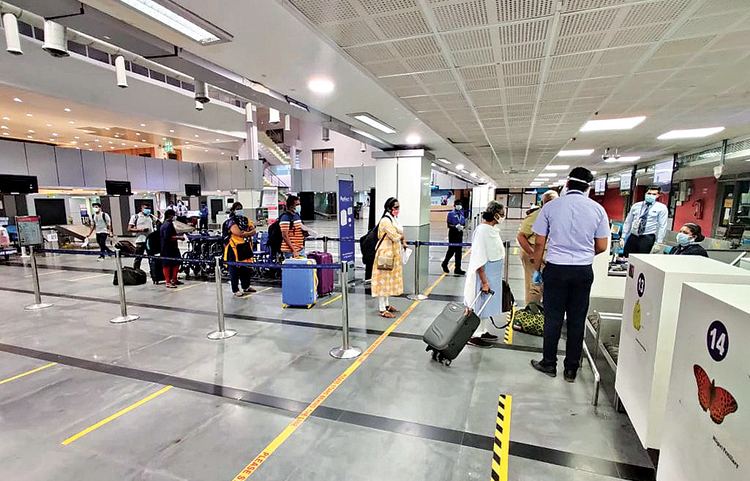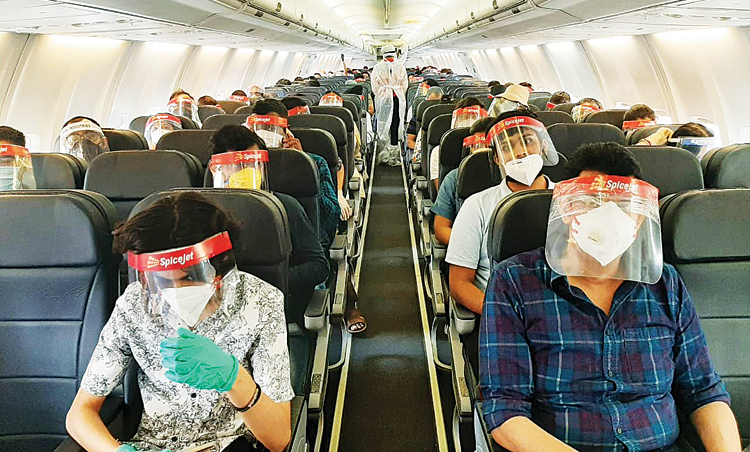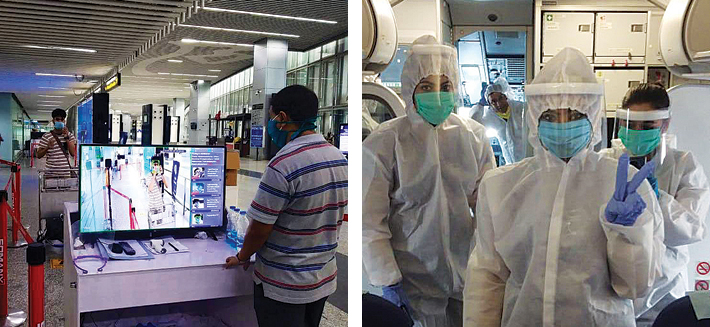Post COVID-19 — Recovery of the Indian Aviation Sector
The aviation sector has to be more careful than ever before as it shoulders the responsibility of safe and sustainable travel for all concerned

COVID-19 AND ITS EFFECTS
In every modern economy, transportation and communication play a vital role since all other services are dependent on these. The COVID-19 pandemic has severely impacted the Indian aviation sector for close to two years now. Its impact has resulted in underserviced flying inventory and ground equipment, mounting interests and deficits in respect of deferred payments. There has virtually been a zero demand for itineraries due to the promulgation of COVID-related travel regulations to stop the spread of infection at the global level as well as within India on the movement of people, goods and aviation assets. The pandemic-initiated lockdown and restrictions have adversely impacted all overseas services, especially the aviation sector with operations being halted globally for over a year. With mild to minimal domestic services being carried out, the aviation sector bled due to the ban on air travel. It is not the first pandemic, but is one of its kind. The world had faced global financial crisis in 2008 which only targeted the economic spending power, but the COVID-19 pandemic has further jolted and altered the consumer behaviour and order as consumers now think critically even before spending on essential items.

The pandemic has influenced the operations and the functioning of the aviation sector. Consequently, all these facets have led to zero demand in the aviation sector during the pandemic. Since there was no air travel demand, the city side infrastructure leading up to and away from the airport has virtually collapsed. The MRO and the spare parts storing infrastructure has also been scaled down and many slow-moving spares were not readily available. The logistics and maintenance channels which moved the spares, passengers and aviation staff also came to a standstill. The most important thing to note is that the latter has been downsized to cut down losses. So, today, most MRO companies are short-staffed to maintain the aviation sector. This is not due to oversight; rather it was the result of an unexpected, unforeseen pandemic or what could be termed as a ‘Black Swan event’.
NEED OF THE HOUR
As the Ministry of Civil Aviation eases COVID-19-related travel restrictions, a thorough analysis is required to identify steps that are needed to ensure fleet efficiency, passenger availability and profitability of the aviation sector to bring it back to the pre-pandemic levels of professional excellence and success. Flight bookings are the financial bloodlines which will enable the revival of the aviation sector. The bump in travel affected the aviation sector that was deprived of the demand and supply element. Various steps have to be taken by the government and the airlines to ensure that the demand for aviation assets is generated. The government also needs to minimise restrictions in flights between regions facing similar pandemic threat. In addition, it may provide visas at a negligible or zero cost to encourage international travel to India and contribute to the Indian GDP. The taxes on Aviation Turbine Fuel, spare parts and services imported by India for running the aviation sector have to be reduced in order to minimise the operating expenses of airlines. This needs to be done on a temporary basis and once a comfortable level is achieved, the taxes and levies can then be brought back to reasonable levels or as deemed fit.
The COVID-19 pandemic has severely impacted the Indian aviation sector for close to two years now
Unnecessary regulations on COVID-19 testing need to be done away with for international travellers. The government has to encourage the UDAN scheme and issue press releases and make the public aware about it. The resumption of air traffic on certain sectors where movement of goods and personal is very prolific will provide a degree of profitability and infuse liquidity in those sectors. It will, of course, have a cascading effect on other sectors too as the demand for movement of passengers and goods in adjacent sectors too will pick up.
Commercial airlines will also have to look beyond their individually guarded passenger shares and may have to resort to sharing of passengers through code shares so that flights go full. This will ensure that the cost of travel will remain affordable and the shared loads will lead to reduced or minimised operating costs and also maximise revenue by having more passengers per flight available rather than having them distributed between different carriers. This will also ensure minimum fuel burn per-passenger-per-mile on a particular sector provided such cooperation and coordination exists between different airlines. Furthermore, there needs to be a fundamental shift in the functioning of the aviation industry. It is also worth noting that that the pandemic is far from over yet. Despite this, the reduced infection rate has facilitated the re-opening of the aviation industry’s gateways. However, this temporary success is vulnerable to another COVID wave.

Post COVID-19, the hub-and-spoke model has to be rejuvenated by first making the spokes profitable. This is possible through the propagation of a region-based UDAN scheme, promoting local short-haul traffic along prominent trade lines. This will ensure that the spokes will get activated and become profitable. It is only then that the hubs will become profitable. This will lead to comprehensive profitability and functionality at optimum levels of the airlines. Airlines have to ensure that they become cash rich even before they start the first flight. This is possible by propagating advance booking with heavy discounts and corporate deals. Funds can be raised through the issue of debentures or shares.
Flight bookings are the financial bloodlines which will enable the ascendancy of the aviation sector
Aviation companies owning aircraft can acquire financial liquidity by selling their machines and leasing them back to get cash to fund their operations. The aviation companies have to tighten their belt by using the push back systems, vigorously using single-engine taxiing to the runway, minimise onboard non-revenue generating loads such as in-flight magazines, provide food through cash sales and very heavily invest in surrogate marketing to generate funds. A considered programme of maintaining the ground-based infrastructure and operational wear-and-tear based MRO contracts will minimise cash outflows.
Airlines need to concentrate more on regional short-haul planes to generate revenue based upon the optimal flight bookings for UDAN flights. Multinational flights are subject to diverse regulations of different countries in terms of COVID-19 protocols. This needs constant and meticulous transnational coordination. As each nation follows a different spacing/seating protocol during the COVID-19, airlines have to sell tickets based upon the least common multiple concepts to maximise their revenue.
To optimise the cost-per-flight, airlines have to rewrite their code shares so that they all come out as a winner. Airlines also need to consider providing bulk ticketing or bulk discounts to organisations that have the ability to provide passengers in bulk such as the defence forces, paramilitary forces, and other organisations in order to ensure that flights do not go empty.
THE HUMAN FACTOR
Most organisations had either offloaded their human resource personal or put them on the bench due to the COVID-19 lockdown. Some trained staff of the aviation sector had moved away or were retrenched. As a result, airlines now need to recruit and train service personnel, ticketing staff, technical staff and form in-flight staff teams. Now, this is the time when they are to start on-boarding all the staff in order to function as a well-oiled team. Consequently, the aviation companies will have to heavily invest in training and skilling this staff. Since the success of the aviation sector depends heavily upon the hospitality, goodwill and the pleasantness which is perceived by the passengers, it is very essential that the companies invest significantly on training the employees so that they are able to maintain the corporate culture as has been articulated in the vision document of the airline.
Post COVID-19, the hub-and-spoke model has to be rejuvenated by first making the spokes profitable
To resuscitate themselves after the pandemic, the aviation companies have to now invest in raising capital, marketing their seats, itineraries of flights and also indulge in innovative marketing to attract customers. They have to prevail upon the government to make aviation and travel more affordable and attractive to both foreign and domestic flyers. Airlines have to operationalise innovatively in a phased manner in order to generate revenues as early as possible.

Human resource is one of the most important factors of production in the aviation sector. Therefore, airlines may have to go the extra mile to recruit proper staff, duly trained and deploy them to make their airlines operational and profitable. To uplift and boost the aviation sector post-pandemic, there lies a greater responsibility for corporate organisations and governments alike to fund, aid and uplift the aviation sector with reformative measures, investments, new schemes and policies.
CONCLUSION
To quote the Union Civil Aviation Minister Jyotiraditya Scindia, “Coronavirus has hit the aviation sector hard, but things are improving. By 2024, we will develop 100 airports in India and create 1,000 air routes and out of the 100 airport targeted, 61 are already connected. Under Prime Minister Modi’s UDAN scheme, a total of 360 air routes have been started.”
Innovative dimensions were developed and adopted with digitisation transforming travel experience, online booking, ticketing, storing vaccination certificates and test results. The aviation sector has to be more careful than ever before as it shoulders the responsibility of safe and sustainable travel for all concerned. Prevention of the spread of COVID-19 infection largely depends on the aviation sector and the precautions it takes. Apart from financial recovery and profits, long-term effects are evolving on the aviation sector ranging from health to hygiene to sanitation and stringent safety strategies.





